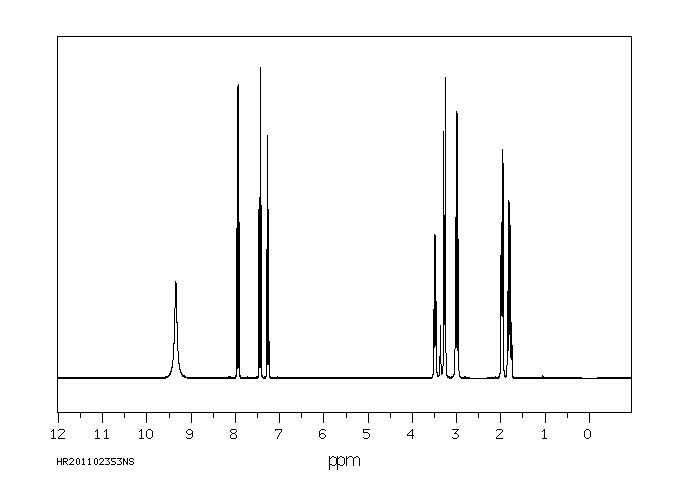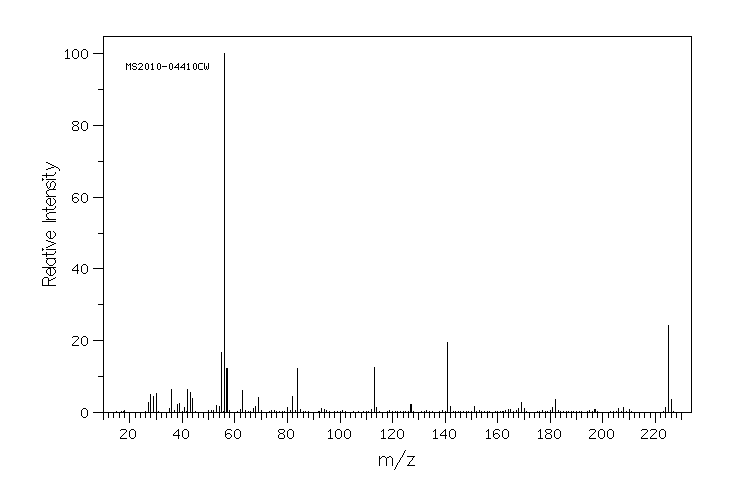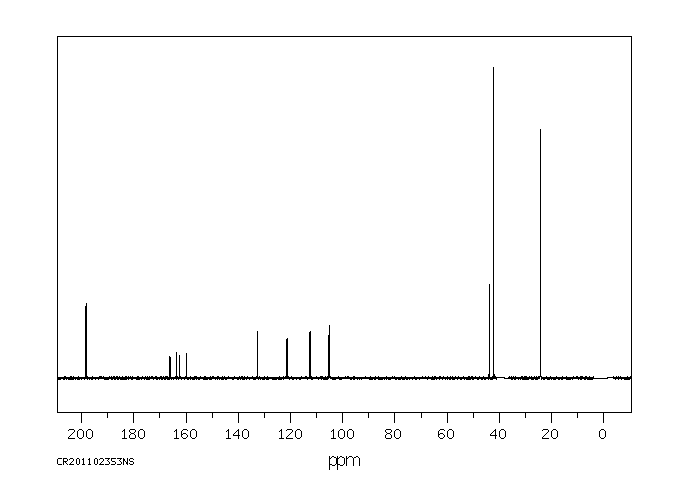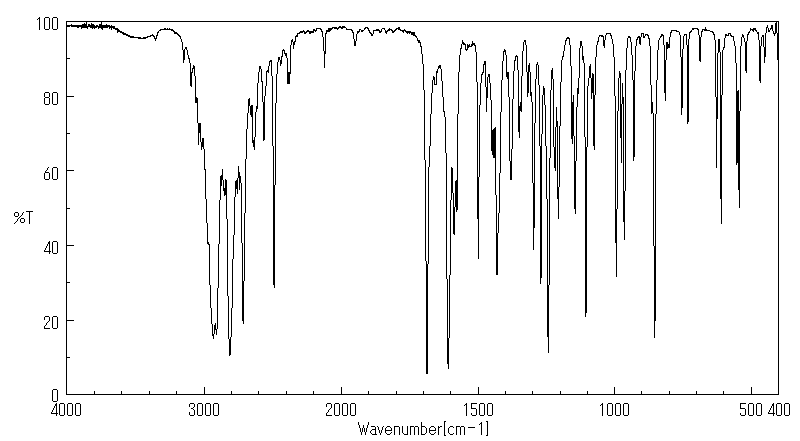4-(2,4-二氟苯甲酰基)-哌啶盐酸盐 | 106266-04-0
中文名称
4-(2,4-二氟苯甲酰基)-哌啶盐酸盐
中文别名
利培酮中间体;4-(2,4-二氟苯酰)哌啶盐酸盐;4-(2,4-二氟苯甲酰)哌啶盐酸盐
英文名称
4-(2,4-difluorobenzoyl)piperidine hydrochloride
英文别名
(2,4-Difluoro-phenyl)-piperidin-4-yl-methanone hydrochloride;(2,4-difluorophenyl)-piperidin-4-ylmethanone;hydrochloride
CAS
106266-04-0
化学式
C12H13F2NO*ClH
mdl
——
分子量
261.699
InChiKey
QPJONRGTWKXJLG-UHFFFAOYSA-N
BEILSTEIN
——
EINECS
——
-
物化性质
-
计算性质
-
ADMET
-
安全信息
-
SDS
-
制备方法与用途
-
上下游信息
-
文献信息
-
表征谱图
-
同类化合物
-
相关功能分类
-
相关结构分类
物化性质
-
熔点:203-206°C (dec.)
-
溶解度:溶于甲醇、水
-
稳定性/保质期:
常温常压下稳定,避免与强氧化剂接触。
计算性质
-
辛醇/水分配系数(LogP):2.57
-
重原子数:17
-
可旋转键数:2
-
环数:2.0
-
sp3杂化的碳原子比例:0.42
-
拓扑面积:29.1
-
氢给体数:2
-
氢受体数:4
安全信息
-
危险品标志:Xn
-
危险类别码:R36/37/38
-
海关编码:2933399090
-
安全说明:S26,S36/37/39
-
危险性防范说明:P261,P305+P351+P338
-
危险性描述:H315,H319,H335
-
储存条件:密封储存,应存放在阴凉、干燥的库房中,并远离氧化剂。
SDS
SECTION 1: Identification of the substance/mixture and of the company/undertaking
Product identifiers
Product name : 4-(2,4-Difluorobenzoyl)Piperidine Hydrochloride
REACH No. : A registration number is not available for this substance as the substance
or its uses are exempted from registration, the annual tonnage does not
require a registration or the registration is envisaged for a later
registration deadline.
Relevant identified uses of the substance or mixture and uses advised against
Identified uses : Laboratory chemicals, Manufacture of substances
SECTION 2: Hazards identification
Classification of the substance or mixture
Classification according to Regulation (EC) No 1272/2008
Acute toxicity, Oral (Category 4), H302
For the full text of the H-Statements mentioned in this Section, see Section 16.
Classification according to EU Directives 67/548/EEC or 1999/45/EC
Xn Harmful R22
For the full text of the R-phrases mentioned in this Section, see Section 16.
Label elements
Labelling according Regulation (EC) No 1272/2008
Pictogram
Signal word Warning
Hazard statement(s)
H302 Harmful if swallowed.
Precautionary statement(s) none
Supplemental Hazard none
Statements
Other hazards
This substance/mixture contains no components considered to be either persistent, bioaccumulative and
toxic (PBT), or very persistent and very bioaccumulative (vPvB) at levels of 0.1% or higher.
SECTION 3: Composition/information on ingredients
Substances
Molecular weight : 261,7 g/mol
Hazardous ingredients according to Regulation (EC) No 1272/2008
Component Classification Concentration
4-(2,4-Difluorobenzoyl)Piperidine Hydrochloride
Acute Tox. 4; H302 <= 100 %
Hazardous ingredients according to Directive 1999/45/EC
Component Classification Concentration
4-(2,4-Difluorobenzoyl)Piperidine Hydrochloride
Xn, R22 <= 100 %
For the full text of the H-Statements and R-Phrases mentioned in this Section, see Section 16
SECTION 4: First aid measures
Description of first aid measures
General advice
Consult a physician. Show this safety data sheet to the doctor in attendance.
If inhaled
If breathed in, move person into fresh air. If not breathing, give artificial respiration. Consult a physician.
In case of skin contact
Wash off with soap and plenty of water. Consult a physician.
In case of eye contact
Flush eyes with water as a precaution.
If swallowed
Never give anything by mouth to an unconscious person. Rinse mouth with water. Consult a physician.
Most important symptoms and effects, both acute and delayed
The most important known symptoms and effects are described in the labelling (see section 2.2) and/or in
section 11
Indication of any immediate medical attention and special treatment needed
No data available
SECTION 5: Firefighting measures
Extinguishing media
Suitable extinguishing media
Use water spray, alcohol-resistant foam, dry chemical or carbon dioxide.
Special hazards arising from the substance or mixture
Nature of decomposition products not known.
Advice for firefighters
Wear self-contained breathing apparatus for firefighting if necessary.
Further information
No data available
SECTION 6: Accidental release measures
Personal precautions, protective equipment and emergency procedures
Use personal protective equipment. Avoid dust formation. Avoid breathing vapours, mist or gas. Ensure
adequate ventilation. Avoid breathing dust.
For personal protection see section 8.
Environmental precautions
Do not let product enter drains.
Methods and materials for containment and cleaning up
Pick up and arrange disposal without creating dust. Sweep up and shovel. Keep in suitable, closed
containers for disposal.
Reference to other sections
For disposal see section 13.
SECTION 7: Handling and storage
Precautions for safe handling
Avoid contact with skin and eyes. Avoid formation of dust and aerosols.
Provide appropriate exhaust ventilation at places where dust is formed.
For precautions see section 2.2.
Conditions for safe storage, including any incompatibilities
Store in cool place. Keep container tightly closed in a dry and well-ventilated place.
Storage class (TRGS 510): Non Combustible Solids
Specific end use(s)
Apart from the uses mentioned in section 1.2 no other specific uses are stipulated
SECTION 8: Exposure controls/personal protection
Control parameters
Components with workplace control parameters
Exposure controls
Appropriate engineering controls
Handle in accordance with good industrial hygiene and safety practice. Wash hands before breaks and
at the end of workday.
Personal protective equipment
Eye/face protection
Safety glasses with side-shields conforming to EN166 Use equipment for eye protection tested
and approved under appropriate government standards such as NIOSH (US) or EN 166(EU).
Skin protection
Handle with gloves. Gloves must be inspected prior to use. Use proper glove removal technique
(without touching glove's outer surface) to avoid skin contact with this product. Dispose of
contaminated gloves after use in accordance with applicable laws and good laboratory practices.
Wash and dry hands.
The selected protective gloves have to satisfy the specifications of EU Directive 89/686/EEC and
the standard EN 374 derived from it.
Body Protection
Complete suit protecting against chemicals, The type of protective equipment must be selected
according to the concentration and amount of the dangerous substance at the specific workplace.
Respiratory protection
For nuisance exposures use type P95 (US) or type P1 (EU EN 143) particle respirator.For higher
level protection use type OV/AG/P99 (US) or type ABEK-P2 (EU EN 143) respirator cartridges.
Use respirators and components tested and approved under appropriate government standards
such as NIOSH (US) or CEN (EU).
Control of environmental exposure
Do not let product enter drains.
SECTION 9: Physical and chemical properties
Information on basic physical and chemical properties
a) Appearance Form: solid
b) Odour No data available
c) Odour Threshold No data available
d) pH No data available
e) Melting point/freezing No data available
point
f) Initial boiling point and No data available
boiling range
g) Flash point No data available
h) Evaporation rate No data available
i) Flammability (solid, gas) No data available
j) Upper/lower No data available
flammability or
explosive limits
k) Vapour pressure No data available
l) Vapour density No data available
m) Relative density No data available
n) Water solubility No data available
o) Partition coefficient: n- No data available
octanol/water
p) Auto-ignition No data available
temperature
q) Decomposition No data available
temperature
r) Viscosity No data available
s) Explosive properties No data available
t) Oxidizing properties No data available
Other safety information
No data available
SECTION 10: Stability and reactivity
Reactivity
No data available
Chemical stability
Stable under recommended storage conditions.
Possibility of hazardous reactions
No data available
Conditions to avoid
No data available
Incompatible materials
No data available
Hazardous decomposition products
In the event of fire: see section 5
SECTION 11: Toxicological information
Information on toxicological effects
Acute toxicity
No data available
Skin corrosion/irritation
No data available
Serious eye damage/eye irritation
No data available
Respiratory or skin sensitisation
No data available
Germ cell mutagenicity
No data available
Carcinogenicity
IARC: No component of this product present at levels greater than or equal to 0.1% is identified as
probable, possible or confirmed human carcinogen by IARC.
Reproductive toxicity
No data available
Specific target organ toxicity - single exposure
No data available
Specific target organ toxicity - repeated exposure
No data available
Aspiration hazard
No data available
Additional Information
RTECS: Not available
SECTION 12: Ecological information
Toxicity
No data available
Persistence and degradability
No data available
Bioaccumulative potential
No data available
Mobility in soil
No data available
Results of PBT and vPvB assessment
This substance/mixture contains no components considered to be either persistent, bioaccumulative and
toxic (PBT), or very persistent and very bioaccumulative (vPvB) at levels of 0.1% or higher.
Other adverse effects
No data available
SECTION 13: Disposal considerations
Waste treatment methods
Product
Offer surplus and non-recyclable solutions to a licensed disposal company. Dissolve or mix the material
with a combustible solvent and burn in a chemical incinerator equipped with an afterburner and scrubber.
Contaminated packaging
Dispose of as unused product.
SECTION 14: Transport information
UN number
ADR/RID: - IMDG: - IATA: -
UN proper shipping name
ADR/RID: Not dangerous goods
IMDG: Not dangerous goods
IATA: Not dangerous goods
Transport hazard class(es)
ADR/RID: - IMDG: - IATA: -
Packaging group
ADR/RID: - IMDG: - IATA: -
Environmental hazards
ADR/RID: no IMDG Marine pollutant: no IATA: no
Special precautions for user
No data available
SECTION 15: Regulatory information
This safety datasheet complies with the requirements of Regulation (EC) No. 1907/2006.
Safety, health and environmental regulations/legislation specific for the substance or mixture
No data available
Chemical Safety Assessment
For this product a chemical safety assessment was not carried out
SECTION 16: Other information
Full text of H-Statements referred to under sections 2 and 3.
Acute Tox. Acute toxicity
H302 Harmful if swallowed.
Full text of R-phrases referred to under sections 2 and 3
Xn Harmful
R22 Harmful if swallowed.
Further information
Copyright 2014 Co. LLC. License granted to make unlimited paper copies for internal use
only.
The above information is believed to be correct but does not purport to be all inclusive and shall be
used only as a guide. The information in this document is based on the present state of our knowledge
and is applicable to the product with regard to appropriate safety precautions. It does not represent any
guarantee of the properties of the product. Corporation and its Affiliates shall not be held
liable for any damage resulting from handling or from contact with the above product. See
and/or the reverse side of invoice or packing slip for additional terms and conditions of sale.
制备方法与用途
制备方法
医药中间体。
用途简介 用途医药中间体。
反应信息
-
作为反应物:描述:4-(2,4-二氟苯甲酰基)-哌啶盐酸盐 在 N-甲基哌啶 、 盐酸羟胺 、 potassium tert-butylate 、 sodium carbonate 、 potassium iodide 作用下, 以 乙醇 、 水 、 N,N-二甲基甲酰胺 、 甲苯 为溶剂, 反应 28.0h, 生成 利培酮参考文献:名称:利培酮的制备方法摘要:本发明公开了一种利培酮的制备方法,属于化学药物中间体制备方法技术领域,利用2,4‑二氟苯基‑4,‑哌啶甲酮盐酸盐和3‑(2‑氯乙基)‑6,7,8,9‑四氢‑2‑甲基‑4H‑吡啶并[1,2‑a]嘧啶‑4‑酮为原料,经肟化、环合和缩合反应制备高纯度利培酮。本发明方法,采用的原料相对廉价易得,操作简单,收率较高,具有较高的工业化价。公开号:CN109438443A
-
作为产物:描述:参考文献:名称:一种6-氟-3-(4-哌啶基)-1,2-苯并异噁唑盐酸盐的纯化方法摘要:本发明公开一种利培酮中间体如式II所示的6‑氟‑3‑(4‑哌啶基)‑1,2‑苯并异噁唑盐酸盐的纯化方法,其特征在于,所述的纯化方法是将6‑氟‑3‑(4‑哌啶基)‑1,2‑苯并异噁唑盐酸盐加入到乙醇中,再加入一定量的水,加热回流至溶清,降温至一定温度进行养晶,然后再降温至‑5~10℃,过滤,烘干得到。本发明提供的6‑氟‑3‑(4‑哌啶基)‑1,2‑苯并异噁唑盐酸盐的纯化方法,能有效地将式Ⅴ二聚体分离出去,纯化收率在85%以上,成品的化学纯度可达到99.9%以上,并且在大生产中不会产生放大效应,工艺稳定。公开号:CN112624992A
-
作为试剂:描述:、 1-[4-(2,4-二氟苯甲酰基)-1-哌啶基]-1-乙酮 、 盐酸 在 异丙醇 、 4-(2,4-二氟苯甲酰基)-哌啶盐酸盐 作用下, 反应 5.0h, 以yielding 39 parts (83%) of (2,4-difluorophenyl)(4-piperidinyl)methanone hydrochloride (intermediate 2)的产率得到参考文献:名称:3-piperidinyl-substituted 1,2-benzisoxazoles and 1,2-benzisothiazoles摘要:3-哌啶基-1,2-苯并异噻唑和3-哌啶基-1,2-苯并噁唑及其药学上可接受的酸盐加合物具有有用的抗精神病特性,并可用于治疗多种以血清素释放为主要因素的疾病。公开号:US04804663A1
文献信息
-
[EN] QUINOXALINE DERIVATIVES AS GPR6 MODULATORS<br/>[FR] DÉRIVÉS DE QUINOXALINE EN TANT QUE MODULATEURS DU GPR6申请人:ENVOY THERAPEUTICS INC公开号:WO2014028479A1公开(公告)日:2014-02-20The present invention provides compounds of Formula (I) that are GPR6 modulators and are therefore useful for the treatment of diseases treatable by modulation of GPR6, in particular treating Parkinson disease, levodopa induced dyskinesias, Huntington's disease, other dyskinesias, akinesias, and motor disorders involving dysfunction of the striatum, schizophrenia and drug addiction. Also provided are pharmaceutical compositions containing such compounds and processes for preparing such compounds.
-
[EN] A PROCESS FOR THE PREPARATION OF ANTIPSYCHOTIC RISPERIDONE<br/>[FR] PROCEDE DE PREPARATION DE RISPERIDONE ANTIPSYCHOTIQUE申请人:AUROBINDO PHARMA LTD公开号:WO2004009591A1公开(公告)日:2004-01-29This invention relates to a process for the preparation of antipsychotic risperidone (Formula I); which comprises reacting 3-(2-chloroethyl)-6,7,8,9-tetrahydro-2-methyl-4H-pyrido-[1,2-a]pyrimidin-4-one (Formula II); with 4-(2,4-difluorobenzoyl)piperidine oxime (Formula III); to form oxime (Formula IV); and in situ cyclization of oxime (Formula IV) to form risperidone (Formula I) in a solvent selected from the group consisting of acetonitrile, N,N-dimetylformamide and methyl isobutyl ketone.
-
[EN] METHOD FOR PREPARING RISPERIDONE<br/>[FR] PROCEDE DE PREPARATION DE LA RISPERIDONE申请人:HANMI PHARM IND CO LTD公开号:WO2004035573A1公开(公告)日:2004-04-29Risperidone is prepared in a high yield by reacting 2,4-difluorophenyl(4-piperidinyl)methanone oxime hydrochloride and 3-(2-chloroethyl)-6,7,8,9-tetrahydro-2-methyl-4H-pyrido[1,2-a]pyrimidin-4-one in an aqueous alkali hydroxide solution having an alkali hydroxide concentration in the range of 20 to 40%.
-
Process for making risperidone and intermediates therefor申请人:——公开号:US20040097523A1公开(公告)日:2004-05-20The formation of risperidone is enhanced by the use of enriched Z-isomer oxime intermediate(s) of formula (3) or (7). 1 The oxime(s) can be isomerically enriched by a variety of techniques including the use of the novel acetic acid salt thereof, which affords, inter alia, resolution of the isomers and/or by heat conversion.
-
一种伊潘立酮中间体的制备方法
表征谱图
-
氢谱1HNMR
-
质谱MS
-
碳谱13CNMR
-
红外IR
-
拉曼Raman
-
峰位数据
-
峰位匹配
-
表征信息
同类化合物
(反式)-4-壬烯醛
(s)-2,3-二羟基丙酸甲酯
([1-(甲氧基甲基)-1H-1,2,4-三唑-5-基](苯基)甲酮)
(Z)-4-辛烯醛
(S)-氨基甲酸酯β-D-O-葡糖醛酸
(S)-3-(((2,2-二氟-1-羟基-7-(甲基磺酰基)-2,3-二氢-1H-茚满-4-基)氧基)-5-氟苄腈
(R)-氨基甲酸酯β-D-O-葡糖醛酸
(5,5-二甲基-2-(哌啶-2-基)环己烷-1,3-二酮)
(2,5-二氟苯基)-4-哌啶基-甲酮
龙胆苦苷
龙胆二糖甲乙酮氰醇(P)
龙胆二糖丙酮氰醇(P)
龙胆三糖
龙涎酮
齐罗硅酮
齐留通beta-D-葡糖苷酸
鼠李糖
黑芥子苷单钾盐
黑海棉酸钠盐
黑木金合欢素
黑曲霉三糖
黑介子苷
黄尿酸8-O-葡糖苷
麻西那霉素II
麦迪霉素
麦芽糖脎
麦芽糖基海藻糖
麦芽糖1-磷酸酯
麦芽糖
麦芽四糖醇
麦芽四糖
麦芽十糖
麦芽六糖
麦芽五糖水合物
麦芽五糖
麦芽五糖
麦芽五糖
麦芽三糖醇
麦芽三糖
麦芽三糖
麦芽三塘水合
麦芽七糖水合物
麦芽七糖
麦法朵
麦可酚酸-酰基-Β-D-葡糖苷酸
麦利查咪
麝香酮
鹤草酚
鸢尾酚酮 3-C-beta-D-吡喃葡萄糖苷
鸡矢藤苷










